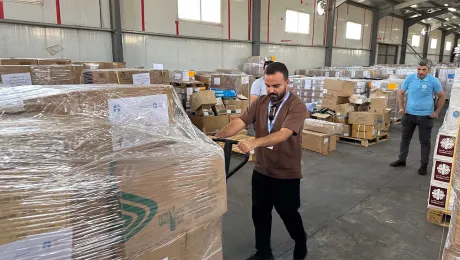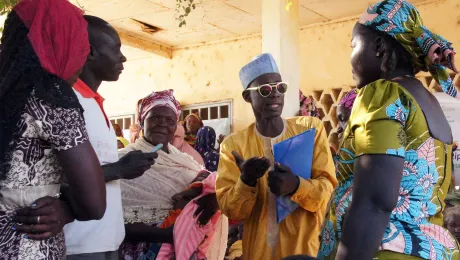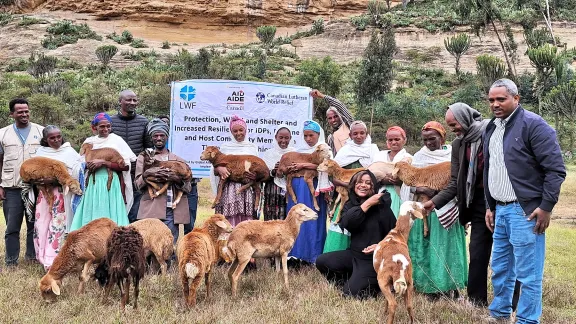
LWF Ethiopia Country Representative Sophia Gebreyes (front, in black) with community members in Adigrat, Tigray 2023. LWF had provided goats and other animals to rebuild livelihoods, and on this visit, they presented the first kids and lambs. Photo: LWF Ethiopia
Turning "despair into hope"
(LWI)—Five decades of refugee response, humanitarian aid in times of natural disaster, human rights advocacy, and constantly building livelihoods for vulnerable communities affected by climate change. The Lutheran World Federation (LWF) has been working in Ethiopia through its humanitarian and development arm, LWF World Service for 50 years. The Ethiopia country program now celebrates these achievements in an anniversary edition of its Annual Report.
LWF Ethiopia started with an invitation from the local LWF member church, the Ethiopian Evangelical Church Mekane Yesus (EECMY), in 1973. "A missive signed by his Eminence Dr Emmanuel Abraham, President of EECMY, was the catalyst to propel LWF World Service (then Lutheran World Service [LWS]) into action in April 1973. At the time, a severe famine was prevailing in the then Wollo, Gojam, and Tigray provinces that the church took it upon herself to raise the alarm and invite the then LWS to respond and to establish a permanent presence in Ethiopia," recalls LWF Ethiopia Country Representative Sophia Gebreyes.
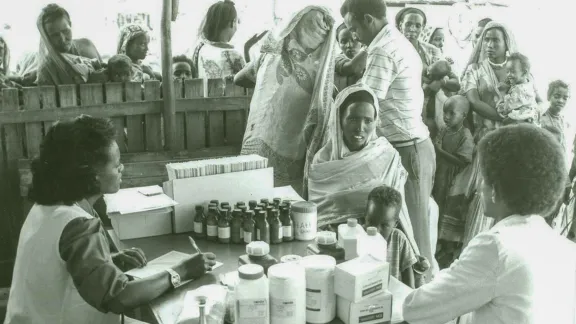
Medical assistance to returnees in Hararghe. The people had fled following the 1977 invasion of Ethiopia by Somalia and returned in 1984. LWF among others provided mother and child healthcare, including immunization. Photo: LWF Archives
Ecumenical partnership
LWS had already provided drought relief in Bichena province the year before. In the 1970s, LWF Ethiopia concentrated its work on emergency relief operations responding to the drought and famine in Wollo and Tigray provinces. In 1974, medical assistance was set up in Kambatta, a disadvantaged province in South-Western Ethiopia, and later people from the drought hit areas in Kambatta were resettled in more fertile land in the country.
In the 1980s, the focus was mainly on building infrastructure and livelihoods, for example, for returnees from Somalia and a fishing community in Massawa. Much of LWF Ethiopia's work was on the new construction of irrigation and water retention structures to support communities in danger of losing their traditional livelihoods to the changing climate. The report lists 90 irrigation schemes, 51 micro dams, and 14 water spring developments between 1985 and 2003.
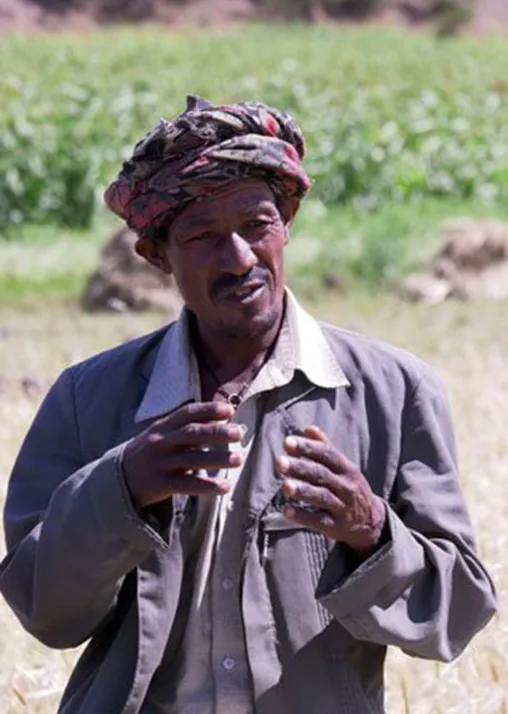
A local farmer in Lalibela explains the effects of climate change on his community. Photo: LWF/ C. Kästner-Meyer
The biggest headlines, however, were the joint drought response of LWF and EECMY to Ethiopia's famine from 1984 to 1992. The church and LWS provided relief goods, agricultural supplies, seeds, and medical supplies to hundreds of thousands of people in five Ethiopian provinces.
"LWS and EECMY's work not only saved very many lives but has also precluded excessive displacement and dependency by using (...) a timely emphasis on replenishment of family seed stock, tools, and livestock. All these efforts by families and aid workers have helped toward transforming disasters into a process of recovery," summarizes sociologist and LWF consultant Peter Esmonde in "The LWF in Ethiopia (1993)".
Appreciation by local church
EECMY President Rev. Dr Yonas Yigezu Dibisa expresses his appreciation for the partnership between LWF World Service and the church over the decades. "We are profoundly grateful for the transformative joint engagement by the LWF and EECMY, which has turned despair into hope and suffering into a promising future," he writes in a message for the report.
Dibisa notes that LWF Ethiopia never limited its work to emergency interventions but "has also taken seriously rehabilitation and development needs in a sustainably impactful manner," putting the needs of the people and the communities affected at the center.
"We deeply appreciate that this enduring relationship has significantly enhanced the diaconal service of the EECMY, enabling us to be agents of life-changing support and compassion," he adds.
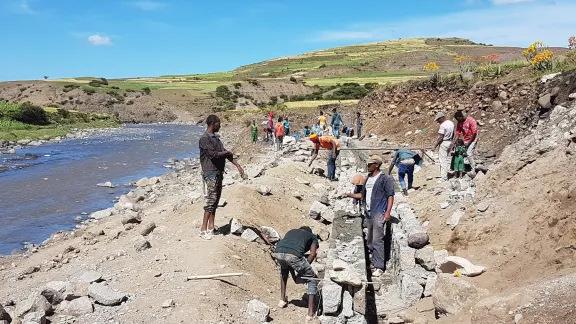
People build an irrigation system as part of an LWF cash-for-work project in 2019. LWF has rebuild and constructed hundreds of dams, water sprigs and irrigation systems during its time in Ethiopia. Photo: LWF/ C. Kästner-Meyer
We will continue to address these crises and challenges building on the past achievements for a bright, peaceful and reconciled Ethiopia.
– Sophia Gebreyes, LWF Country Representative in Ethiopia
Armed conflict and refugees
While development work for communities affected by natural disasters and climate change is at the heart of the program, in recent years, much of the work has focused on humanitarian aid in external and internal armed conflict. Since the early 1980s, LWF Ethiopia has been engaged in the Sudanese refugee response from what in 2011 became South Sudan and later supported South Sudanese refugees, refugees from Somalia, and most recently from Sudan.
In 2023, humanitarian response accounted for 70 percent of the country program's expenditure, supporting people affected by the conflict in Tigray and Amhara Regional States and life-saving interventions for communities affected by the drought in the East and Horn of Africa.
"Ethiopia is still grappling with multiple complex crises, eerie echoes of conflicts past, resulting in massive deaths and displacement," Country Representative Gebreyes notes. "We will continue to address these crises and challenges, building on the past achievements for a bright, peaceful, and reconciled Ethiopia."
